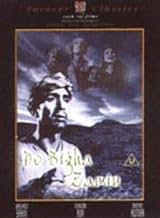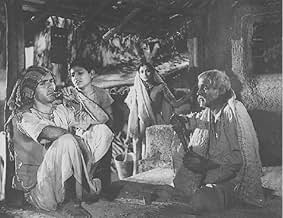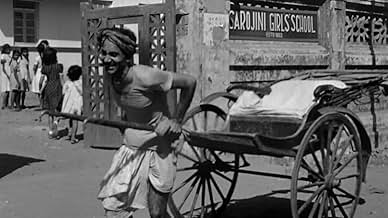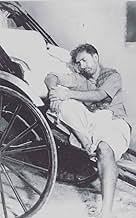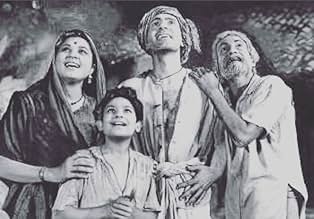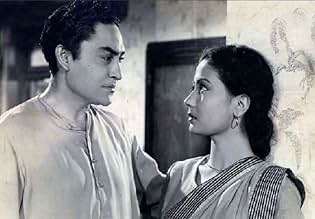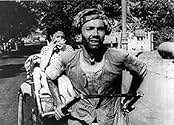IMDb RATING
8.3/10
2.4K
YOUR RATING
In the hope of earning enough money to pay off his debts and save his land, a poor farmer becomes a rickshaw puller in Calcutta and faces many difficulties.In the hope of earning enough money to pay off his debts and save his land, a poor farmer becomes a rickshaw puller in Calcutta and faces many difficulties.In the hope of earning enough money to pay off his debts and save his land, a poor farmer becomes a rickshaw puller in Calcutta and faces many difficulties.
- Director
- Writers
- Stars
- Awards
- 4 wins & 2 nominations total
Ratan Kumar
- Kanhaiya Maheto
- (as Rattan Kumar)
Rajlakshmi Devi
- Nayabji
- (as Rajlakshmi)
Nasir Hussain
- Rickshaw puller
- (as Nazir Hussain)
Ramayan Tiwari
- Paro's molester
- (as Tiwari)
- Director
- Writers
- All cast & crew
- Production, box office & more at IMDbPro
Featured reviews
After watching the Satyajit Ray films, The Apu Trilogy (1955-1959) and Devi (1960), I decided to check out some of the realistic films directed by other Bengali filmmakers during that same era. One of the films I found was Do Bigha Zamin, which won the International Prize at the 1954 Cannes Film Festival.
Although it's a Hindi-language film, and therefore technically a 'Bollywood' movie, the film's director Bimal Roy is from Bengal, thus the film has more in common with Bengali art cinema than it does with mainstream Bollywood as a result. The film does have a few musical numbers, like a lot of other Hollywood and Bollywood movies of that era, but what sets Do Bigha Zamin apart is its greater sense of realism. Beyond the few musical numbers, the film itself doesn't have much melodrama to it and there isn't much of a background score either, which is a good thing to me as a sappy or sentimental score isn't necessary for a film like this.
Do Bigha Zamin is very much a character-driven drama and the actors did a great job in portraying their respective characters. The performances which stand out most are Balraj Sahni as the farmer Shambu, the protagonist of the story, and the child actor Rattan Kumar as his son Kanhaiya. Nirupa Roy also gave a very good performance as Shambu's wife Paro.
As for Bimal Roy's direction, the film has one of the best depictions of poverty I've ever seen, covering both rural poverty in a Bengali village and urban poverty in Calcutta (now Kolkata), including the plight of street kids living in the city's slums. The film's ending was also powerful and it was overall a very moving film.
8/10
Although it's a Hindi-language film, and therefore technically a 'Bollywood' movie, the film's director Bimal Roy is from Bengal, thus the film has more in common with Bengali art cinema than it does with mainstream Bollywood as a result. The film does have a few musical numbers, like a lot of other Hollywood and Bollywood movies of that era, but what sets Do Bigha Zamin apart is its greater sense of realism. Beyond the few musical numbers, the film itself doesn't have much melodrama to it and there isn't much of a background score either, which is a good thing to me as a sappy or sentimental score isn't necessary for a film like this.
Do Bigha Zamin is very much a character-driven drama and the actors did a great job in portraying their respective characters. The performances which stand out most are Balraj Sahni as the farmer Shambu, the protagonist of the story, and the child actor Rattan Kumar as his son Kanhaiya. Nirupa Roy also gave a very good performance as Shambu's wife Paro.
As for Bimal Roy's direction, the film has one of the best depictions of poverty I've ever seen, covering both rural poverty in a Bengali village and urban poverty in Calcutta (now Kolkata), including the plight of street kids living in the city's slums. The film's ending was also powerful and it was overall a very moving film.
8/10
Of course it is true that Do Bigha Zamin is strongly influenced by Vittorio de Sica's neorealist classic Bicycle Thieves (very improperly retitled Bicycle Thief in the English version). But De Sica's film has influenced virtually every realist film (and many non-realist films) ever since the day it first appeared. It is a crucial reference in world cinema and will probably always remain one.
It was of course particularly influential on all the Indian neo-realists of the fifties, including the greatest of them all - Satyajit Ray. Roy, like Ray a Bengali, would have imbibed that influence before ever he abandoned New Theatres in Calcutta to come to Bombay. He is not an especially innovative director. Devdas (1955) for instance is essentially a Hindi remake of a thirties classic of Bengali cinema; other Roy films show an eclectic range of influences. So it is not surprising to find him in Do Bigha Zamin attempting to adapt the style (and to some extent) the structure of Bicycle Thieves to an Indian context.
Once one has admitted that, however, it should not I think be seen as some sort of shameful plagiarism and one can go on to appreciate some of the real plusses of Roy's film. It is true that it is less restrained than the Italian model; Roy piles on the agony in no uncertain terms and tends to oversentimentalize. Note however that he resists any facile optimism...
The adaptation to a rural Indian context alters the politics of the film, concentrating on the issue (a burning issue to this day in rural India) of the cycle of debt and exploitation to which small peasant farmers in India are subjected (a theme that Mehboob Kahn had already explored in his film Aurat and would do again most famously in Mother India in 1957). This is a less subtle theme perhaps than that of De Sica (where in an urban context it is the poor who steal from the poor and prolong the cycle of misery) but it is nonetheless an important one and Roy (and Balraj Sahni who is excellent) paints a convincing picture of village-life and rural values.
Roy very deliberately counterbalances the picture of misery (rural and urban) with examples of solidarity, of the poor helping the poor, whether on the level of the adults or of the street-boys. And perhaps the most touching and most natural part of Roy's film - and something that owes nothing to De Sica - is his portrayal of the street-kids of Calcutta (which very interestingly prefigures Mira Nair's much later Salaam Bombay). Instead of being isolated companions as in the De Sica film, the father and son in Roy's film experience two rather different aspects of urban life and this layering of the story is perhaps Roy's most significant achievement.
Can one put paid once and for all, finally, to this idea that a realistic film or a film showing social awareness is uncharacteristic of Indian cinema (based on an essentially modern image of "Bollywood")? The golden age of Indian cinema (say 1949 to 1964) abounds in realistic films and films which, while not necessarily realistic in a strict sense of the term, show a good deal of social awareness. It is the period that includes the most memorable films of Satyajit Ray, Rithwik Gathak and Tapan Sinha, the films of Guru Dutt, the early films of Raj Kapoor, those of Bimal Roy, Mehboob Kahn's Mother India but also amongst relatively minor films, Arora's Boot Polish and B R Chopra's Naya Daur. To say nothing of great films in a non-realistic genre such as Mughal-e-Azam (1960) and Pakeezah (largely filmed during the period although not completed until 1972). By comparison with any contemporary cinema anywhere in the world including certainly American cinema, including even that of Japan (also experiencing something of a golden age at that time), it is a very impressive record.
Roy may not be amongst the first rank of cinematic geniuses - I would not put him in the same class as Ray or Gathak or for that matter as Guru Dutt, in my view the finest of the Hindi film directors of the period. He was a populariser (quite determinedly so) and constituted as such an important bridge between the more 'arty' Bengali and more 'popular' Hindi film industries of the time. His contribution remains an important and enduring one to an Indian cinema (and a popular Indian cinema) of real quality that has nothing to do with "Bollywood"...
It was of course particularly influential on all the Indian neo-realists of the fifties, including the greatest of them all - Satyajit Ray. Roy, like Ray a Bengali, would have imbibed that influence before ever he abandoned New Theatres in Calcutta to come to Bombay. He is not an especially innovative director. Devdas (1955) for instance is essentially a Hindi remake of a thirties classic of Bengali cinema; other Roy films show an eclectic range of influences. So it is not surprising to find him in Do Bigha Zamin attempting to adapt the style (and to some extent) the structure of Bicycle Thieves to an Indian context.
Once one has admitted that, however, it should not I think be seen as some sort of shameful plagiarism and one can go on to appreciate some of the real plusses of Roy's film. It is true that it is less restrained than the Italian model; Roy piles on the agony in no uncertain terms and tends to oversentimentalize. Note however that he resists any facile optimism...
The adaptation to a rural Indian context alters the politics of the film, concentrating on the issue (a burning issue to this day in rural India) of the cycle of debt and exploitation to which small peasant farmers in India are subjected (a theme that Mehboob Kahn had already explored in his film Aurat and would do again most famously in Mother India in 1957). This is a less subtle theme perhaps than that of De Sica (where in an urban context it is the poor who steal from the poor and prolong the cycle of misery) but it is nonetheless an important one and Roy (and Balraj Sahni who is excellent) paints a convincing picture of village-life and rural values.
Roy very deliberately counterbalances the picture of misery (rural and urban) with examples of solidarity, of the poor helping the poor, whether on the level of the adults or of the street-boys. And perhaps the most touching and most natural part of Roy's film - and something that owes nothing to De Sica - is his portrayal of the street-kids of Calcutta (which very interestingly prefigures Mira Nair's much later Salaam Bombay). Instead of being isolated companions as in the De Sica film, the father and son in Roy's film experience two rather different aspects of urban life and this layering of the story is perhaps Roy's most significant achievement.
Can one put paid once and for all, finally, to this idea that a realistic film or a film showing social awareness is uncharacteristic of Indian cinema (based on an essentially modern image of "Bollywood")? The golden age of Indian cinema (say 1949 to 1964) abounds in realistic films and films which, while not necessarily realistic in a strict sense of the term, show a good deal of social awareness. It is the period that includes the most memorable films of Satyajit Ray, Rithwik Gathak and Tapan Sinha, the films of Guru Dutt, the early films of Raj Kapoor, those of Bimal Roy, Mehboob Kahn's Mother India but also amongst relatively minor films, Arora's Boot Polish and B R Chopra's Naya Daur. To say nothing of great films in a non-realistic genre such as Mughal-e-Azam (1960) and Pakeezah (largely filmed during the period although not completed until 1972). By comparison with any contemporary cinema anywhere in the world including certainly American cinema, including even that of Japan (also experiencing something of a golden age at that time), it is a very impressive record.
Roy may not be amongst the first rank of cinematic geniuses - I would not put him in the same class as Ray or Gathak or for that matter as Guru Dutt, in my view the finest of the Hindi film directors of the period. He was a populariser (quite determinedly so) and constituted as such an important bridge between the more 'arty' Bengali and more 'popular' Hindi film industries of the time. His contribution remains an important and enduring one to an Indian cinema (and a popular Indian cinema) of real quality that has nothing to do with "Bollywood"...
This movie is a an Indian classic.... I don't know why so many people here are going on about how unrealistic it is...... I would wonder how many who commented as such have actually been to that part of India and witnessed the poverty there....
The story may well have been copied but the film is no doubt still great. I cant think of many other copies which are actually good. This film does actually touch you with its sadness, and claims of melodramaticness will be gladly tossed aside because we are talking about Indian cinema here...
All in all i think this is definitely a gem in Indian cinema, and fit the bill of an all time classic.
The story may well have been copied but the film is no doubt still great. I cant think of many other copies which are actually good. This film does actually touch you with its sadness, and claims of melodramaticness will be gladly tossed aside because we are talking about Indian cinema here...
All in all i think this is definitely a gem in Indian cinema, and fit the bill of an all time classic.
Made in 1953, with a socialist theme that was typical of many great bengali directors, this was a great film with superlative performances and very real feel to the film. Balraj Sahni, one of the five greatest actors of India ever, was simply stunning in this movie in terms of his natural acting and superior understanding of the life of a peasant first and then a novice rickshaw (two wheel cart pulled by a human, instead of the horse) puller fresh in the city (He naturally doesn't know that once u take a passenger to the destination, u have to hold it down so that the passenger can alight - he nervously waits for his first dime)..Ill have to come back and write more..sorry
I have seen Do Bigha Zamin many times ( at least five ) but never had a chance to write a review. Every time I see this movie I put my hats off to Mr. Bimal Roy as the director of this masterpiece. I have read comments about having the idea from a different film ( Vittorio Di Sica's Bicycle Thief ) But I can challenge a lot of director to copy any film they want and produce something like Do Bigha Zamin. The scenes of a village in Bengal and the streets of Calcutta ( now Kolkata ) in early fifties are so real - it just sends shivers through my body. I was a student in a Calcutta college during that period and the scenes from Esplanade area, with Metro Cinema, Chowringhee Road, the double decker buses, the trams and finally the human rickshaws were presented in such a way that I felt being there in that period. The poverty of the villagers and as well as the bustee dwellers were very realistic and the characters were portrayed and played extremely well. Some of the scenes like when Paro went to Meena Kumari to get a letter written, the short scene where Nirupa Roy complaining to Balraj Sahni that he does not love her are very touching scenes. One of the other wonders are the boot polish kid Laloo. I don,t know whether he is an actor or real boot polish kid in real life , but he displayed a wonderful piece of acting as the friendly companion to Kanhaiya ( Rattan Kumar ). Nirupa Roy as the wife of the peasant Balraj Sahani, Balraj Sahani himself and Rattan Kunmar all played their parts very well. I should also mention the role played by Rajlakhsmi Devi as the Bustee owner - what can be more realistic than that. Though the economic scene in India has changed over the last sixty years still there are a lot of poverty in India and peasants like Shambhu Mahato can be found all over India. I appreciate the director's last scene where it shows the family is still intact with hope for the future at the same time the struggle for survival goes on as they lost their land to the greedy landlord. I have the DVD and will watch it many more times.
Did you know
- TriviaWhen the shoeshine boys discuss seeing Nargis in Le vagabond (1951), one of them alludes to a shirt worn by a bystander. The shirt is decorated with a recurring pattern showing the famous scene from Le vagabond (1951) in which Raj Kapoor comes upon Nargis as she is changing clothes, partially hidden by a screen, after swimming. That scene occupies a place in Hindi cinema comparable to that of Deborah Kerr and Burt Lancaster on the beach in Tant qu'il y aura des hommes (1953).
- ConnectionsFeatured in Century of Cinema: 100 ans de cinéma: 100 ans de cinéma indien (1996)
- Soundtrackshariyaala saawan dhol bajaata aaya
Sung by Lata Mangeshkar, Manna Dey
2025 Venice Film Festival Guide
2025 Venice Film Festival Guide
See the full lineup for the 2025 Venice Film Festival, taking place Aug. 27 – Sept. 9, 2025.
- How long is Do Bigha Zamin?Powered by Alexa
Details
- Runtime
- 2h 11m(131 min)
- Color
- Aspect ratio
- 1.37 : 1
Contribute to this page
Suggest an edit or add missing content


